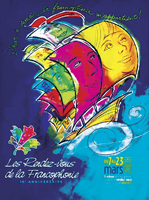Three online classes I viewed and enjoyed among others:
☞ I like the class designed by Janeen Apalatea: similar to Blackboard in regards to the layout and very clear for anyone accessing it. I like the divisions on a weekly basis and the sections to the left with “student ressources,” etc. I do some similarity with my own Blackboard. More details than mine, of course since it is an online class.
☞ Trisha Hanada-Roger: very rich in information. I am very impressed by the number of files, images, etc. which are part of this online class: the sky is not the limit about this course: I see it as being very complete for online students or just any students curious to know about dances all over the world (extra credit opportunities, dance videos, shared discussions about various topics, tutorials, etc.) There are aspects of it I could learn from if I ever design an online class in the future.
☞ Jean Proppe‘s class was very good also: all the field trips were listed with very good descriptions about each one.
The three courses use the same format: the weekly layout, which I like very much. It is clear and you know what to expect to do. I use this but I also give myself more options: a mix bag of weekly, daily tasks and the entire semester ➸ the latter focuses on titles of assignments but details are given a few weeks before as we get near to the due date).
Ideas after viewing these online classes: planning a class ⬇
I would need to prospect some new technology:
Jing, Moodle ressources MLS and the directory structure to manage files on T. Hanada Roger’s class. The chat room also is something I never used in Blackboard but having a hybrid class, I have not contemplated the possibility or even the desire to use it. My students at the present time do not want an online class because it is simply not the purpose for now but I might add a few more things for “testing” purposes.
I now need to make some research about Jing, Flicker and other online help. I am not sure what to use yet and what can be really useful and easy for both the the teacher and the student.
Chapter 3 “Teaching online” on how to build a class:
➸ The feedback is very important: how to improve a class by asking students what could be better to make it “profitable” to them. The feedback from the teacher is essential but asking students what they think is too. Individualized comments on specific assignments and general comments as well for the entire class for the same assignments also so that students can see that the teacher cares about each individual and for the entire class as well. It also shows what other classmates do or think. Community effort.
➸ Ideas on group projects / assignments: to start them early is an excellent option besides the individual projects. It is clear that both are essential to an online class.
➸ The section on “Redesign from longer to shorter:” the tendency to say and to add too many subjects should be cut down whenever necessary. You don’t want to overwhelm students by throwing too much at them: it is a question of selecting the right material. One topic can be chosen without adding several sub-topics, which could be redundant.
Being practical (what to add, what not to select) and understanding the purpose of the class (what I want students know about my class) are the essential keys.



